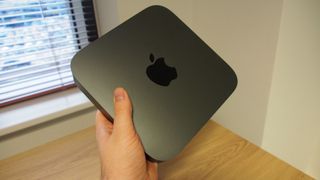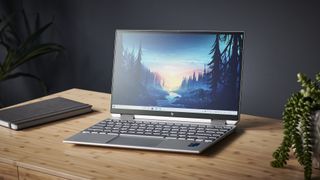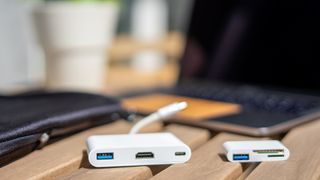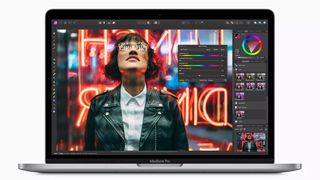Is the Apple M1 really the best mobile processor? We put it to the test
Analysis: is Apple on top of the CPU world yet?

Apple launched its M1 MacBook Pro, MacBook Air and Mac mini back in November 2020, and you’ve probably heard by now just how awesome they are. Intel definitely heard, too. Team Blue has even run an ad campaign blasting Apple’s new M1 processor.
I got a chance to talk to Intel about it, and I was told that while the chip manufacturer acknowledges that the M1 is a good chip, the question about whether it’s right for everyone is a bit more complicated than just running a few benchmarks – while also providing us with benchmarks that showed Intel’s 11th-generation Tiger Lake processor with leads in certain workloads.
But Intel went a bit further, too. Team Blue loaned us a bit of hardware to see just how much of a difference the M1 makes, and combined with some of the hardware I had lying around, I put a M1 MacBook Pro and Mac mini to the test against a laptop with an 11th-generation Intel Core i7 processor and an AMD Ryzen 4000 chip to figure out which platform is going to be the best for you.
With so many different processor options on the market, now that Apple has exploded onto the scene, it’s important to know exactly what you’re getting into – especially when you’re spending upwards of a thousand bucks.
- These are the best motherboards of 2021

The testing
Mac mini:
CPU: Apple M1
GPU: Apple M1
RAM: 16GB
Storage: 512GB SSD
Macbook Pro
CPU: Apple M1
GPU: Apple M1
RAM: 8GB
Storage: 256GB SSD
HP Spectre x360 13
CPU: Intel Core i7-1165G7
GPU: Intel Iris Xe graphics
RAM: 16GB
Storage: 1TB SSD
Lenovo Yoga Slim 7
CPU: AMD Ryzen 7 4800U
GPU: AMD Radeon graphics
RAM: 16GB
Storage: 1TB SSD
It is incredibly hard to find a way to test a gathering of laptops and produce any kind of reliable data from it. There is naturally going to be a lot of variation when there is no way to control the hardware you’re reviewing. Differences in CPU performance can be vast when you’re looking at two laptops with the same processor, thanks to different ways laptop manufacturers configure their products. And it just gets worse when you’re comparing different laptops with different processors.
I tested four different laptops, the specs of which are listed over on the right. The HP Spectre x360 13, the Lenovo Yoga Slim 7, a 13-inch MacBook Pro and the Mac mini. The most eagle-eyed among you have probably already noticed the biggest problem here, though. Intel lent us an M1 MacBook Pro and a HP Spectre x360 13 for this feature, but there is a massive difference in memory – 8GB for the MacBook Pro and 16GB for the HP Spectre x360.
Luckily I had an M1 Mac mini lying around with 16GB of RAM. It didn’t make much of a difference, but I wanted to make sure that I was testing on as equal a ground as possible.
Get the best Black Friday deals direct to your inbox, plus news, reviews, and more.
Sign up to be the first to know about unmissable Black Friday deals on top tech, plus get all your favorite TechRadar content.
But while I could work to make the laptops equal in terms of RAM, the processors themselves have wildly different specs. The AMD Ryzen 7 4800U is an 8-core, 16-thread processor with a max boost of 4.2GHz. Meanwhile, the Intel Core i7-1165G7 in the HP Spectre x360 has just 4 cores and 8 threads, but boosts to a much higher 4.7GHz.
The Apple M1 has a much lower boost of 3.2GHz, but it has 8-cores and 8-threads. However, because it’s based on an ARM design, it follows a big.LITTLE design philosophy, with 4 high-performance cores and 4 high-efficiency cores, which is what lends to its long battery life.

Performance
It’s probably not terribly surprising that Intel is no longer on top of the silicon pile when it comes to raw performance. This was true even before the Apple M1 came out back in November 2020. But it’s not like the Apple M1 has suddenly shot up to the top of the charts when it comes to performance – AMD still wears the crown.
The Lenovo Yoga Slim 7, powered with the AMD Ryzen 7 4800U, was the fastest laptop in all of my tests except for exporting video in Adobe Premiere and in Geekbench. This is thanks in large part to software enhancements present in both Intel’s platform and in Apple’s. In workloads that require a lot of brute force, however, like 3D Modeling in Blender, the AMD Ryzen 7 4800U was more than twice as fast as the Intel Core i7-1165G7.
Team Red’s processor was still a bit faster than Apple’s here, but the gap wasn’t as wide – and this is based on the public version of Blender 2.92.0, not the beta, which is optimized for Apple silicon. So, the M1 should get even faster in the future.









In synthetic benchmarks like GeekBench or Cinebench, the M1 also shines. AMD wins in Cinebench Multi-Core, which is not surprising in the least, but Apple manages to beat AMD in Geekbench 5.3.
Interpreting Geekbench results is kind of complicated, because it is a synthetic benchmark that tests a wide range of workloads in a short period of time. It’s not exactly a realistic real-world workload so it shouldn’t be the penultimate test that a processor lives or dies by. What it does do well, however, is give a general idea of that processor’s potential performance.
And because the Apple M1 processor is such a new platform, a Geekbench score that’s a whopping 20% faster than a Zen 2 Ryzen 7 processor means that as more developers start optimizing their programs for Apple’s silicon, Apple could really start to take a performance lead.
When I’m talking about the reality right now, though, Apple’s claims that its M1 processor is the fastest processor in its class are, at best, a bit misleading. Though, it is pretty damn impressive from a pure performance perspective.

A day in the life
So, Apple and AMD are both putting out incredibly powerful processors for laptops, but unlike the world of desktop PCs, performance isn’t exactly the end of the conversation. There is a lot more that goes into buying the right laptop for your needs, than there is in looking at a bunch of benchmarks and picking the best processor to build your new PC around.
And, in a lot of ways, Intel is still pretty far ahead of both Apple and AMD in this regard. Simply navigating around the desktop on the HP Spectre x360 is incredibly smooth, and everything is incredibly responsive, whether or not I’m currently plugged into the wall. Our Lenovo Slim 7 on battery isn’t quite as responsive, but the problem vanishes as soon as you plug it into the wall.
But while the Intel Evo program has ensured a strong standard of everyday desktop performance, the M1 feels just as smooth and responsive as the laptop equipped with an 11th-generation Intel Core i7 – whether I’m talking about the Mac mini or the MacBook Pro.
At the end of the day, Intel might have a robust program in place to make sure laptops that use its branding live up to the company’s standards, Apple designs all of its computers in-house, so it definitely has an advantage there.
One area where Intel is far and away better than either AMD or Apple, however, is compatibility, thanks to Thunderbolt 4. Now, USB 3.2 Gen 2x2 is definitely a thing, but it’s not as fast or as flexible as Intel’s Thunderbolt standard.

For one thing, USB 3.2 SuperSpeed ports are limited to 20Gbps of bandwidth. Thunderbolt 4 doubles this potential throughput at 40Gbps, and it also allows for more advanced devices to be connected. This means that you can’t use something like the Razer Core X on either an AMD or a MacBook Pro.
External GPUs aren’t exactly the most necessary use of the technology – gaming performance isn’t great, so they’re really best used for folks that need to boost video editing performance when they’re docked at work. What’s a far more popular use for Thunderbolt 3 is docks.
Especially for folks that are now working at home with just a laptop, a Thunderbolt 3 dock gives you access to way more ports than can feasibly fit on a thin and light laptop like a MacBook or an HP Spectre. The Thunderbolt 3 dock I regularly use, the Corsair TBT100, will give you access to a Gigabit Ethernet, 2 USB 3.1 Type-A ports, 2 USB 3.1 Type-C ports, an SD card reader, two HDMI ports and audio out. All of that is through a single port, and it charges the laptop at the same time.
There are docks available that use USB 3.2 Gen 2x2, of course, but because of the limited bandwidth, they aren’t quite as robust as a Thunderbolt dock can be. And, if you’re a creative professional that needs to have a lot of devices and media connected while you’re working, Thunderbolt is still probably the best way to go.
When USB 4.0 comes out, Intel’s advantage here will wane, as it will have similar specifications to Thunderbolt 3, but that’s still a little way into the future, so doesn’t really matter for folks that need to buy a laptop right now.
You also can’t talk about laptops in 2021 without bringing up battery life. Most ultraportable laptops are going to get you through a full work day without fail, and you can even watch a ton of Netflix on these laptops before they bite the dust – but how long do they last when they’re idling?
About two weeks passed since I put these laptops through the test, mostly because I shifted my focus to the Nvidia GeForce RTX 3060. However, while we were testing that new graphics card, and all three of these laptops were just sitting in our apartment without being charged, I was wondering which ones would still have battery left when we finally turned them on.
Well, technically, all of them did, but the MacBook Pro and the Lenovo Slim 7 were almost dead, while the HP Spectre x360 still had 83% battery life remaining. I do a lot of my work from our gaming PC during lockdown, so knowing that a laptop isn’t going to need to be recharged when I ignore it for a week is a nice feeling.

What does it all mean, what should I buy?
If you’re looking for an easy “definitely buy this” recommendation that applies to everyone, I can't really help you there. The best laptop, even in the face of these new Mac processors is still a matter of figuring out what’s right for your specific needs.
If you’re always going to be using your laptop when it’s plugged in and you just need the fastest performance, you should buy a desktop. But if you don’t want to do that, an AMD-powered laptop is going to be the next best thing. Having an 8-core, 16-thread CPU in a laptop was a game changer in 2020, and it’s only going to get better once AMD Ryzen 5000 laptops are more available later this year.
And, the things that made Macs great before Intel got booted from the MacBook Pro and MacBook Air are still largely there. For folks that just like the cleaner aesthetic of macOS, and need programs that are exclusive to Apple’s platform, the MacBook Pro is still the way to go – especially if you’re already into Apple’s Ecosystem.
Intel gets a lot of flak these days – rightfully so – but when it comes to mobile, it’s definitely still worth picking up a laptop with a Core processor. What you lose in brute force, you gain in flexibility and compatibility.
Apple and AMD are doubtlessly working to fine-tune their silicon on mobile computing devices, and once both companies catch up, Intel is going to be in hot water unless it can really push things to the next level. Intel had trouble when AMD caught up to it with Ryzen on desktop, and now Intel is facing a battle on two fronts, how much longer can it stay dominant? I don’t know, but I’m excited to see what will happen.
Jackie Thomas is the Hardware and Buying Guides Editor at IGN. Previously, she was TechRadar's US computing editor. She is fat, queer and extremely online. Computers are the devil, but she just happens to be a satanist. If you need to know anything about computing components, PC gaming or the best laptop on the market, don't be afraid to drop her a line on Twitter or through email.
Most Popular

